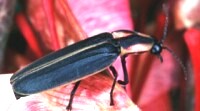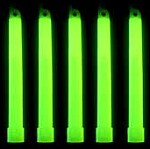FireFlies

 The Firefly is sometimes called a Lightning Bug or Glowworm, but is actually a small beetle. North American fireflies are usually tiny, and can be mistaken for mosquitoes as they float around or sit on a leaf, until you see them up close, or until they flash a tiny light at you! The Firefly is sometimes called a Lightning Bug or Glowworm, but is actually a small beetle. North American fireflies are usually tiny, and can be mistaken for mosquitoes as they float around or sit on a leaf, until you see them up close, or until they flash a tiny light at you!
 Fireflies are beetles in the family Lampyridae, with two sets of wings (like all other insects except true flies, which have just one pair).
Most firefly species are bioluminescent as adults; they 'light up' by mixing chemicals in their bodies.
Fireflies are often found around water, near ponds, streams, or marshes.
Fireflies are beetles in the family Lampyridae, with two sets of wings (like all other insects except true flies, which have just one pair).
Most firefly species are bioluminescent as adults; they 'light up' by mixing chemicals in their bodies.
Fireflies are often found around water, near ponds, streams, or marshes.
 Almost 100% of the energy in firefly's light is given off as light. By comparison, a normal lightbulb gives off just 10% light and 90% heat.
Almost 100% of the energy in firefly's light is given off as light. By comparison, a normal lightbulb gives off just 10% light and 90% heat.
The chemical reaction that does this is very efficient.
Learn more about the bioluminescence reaction here.
 The chemicals that produce this light, particularly a chemical called luciferin, can now be synthesized in a laboratory, and are used in common glow sticks, which mix chemicals to give off a bright but cool light.
The chemicals that produce this light, particularly a chemical called luciferin, can now be synthesized in a laboratory, and are used in common glow sticks, which mix chemicals to give off a bright but cool light.
They also have medical applications. Because luciferin reacts to a substance in living organisms (ATP), scientists use it to detect bacteria.
By using luciferin in blood or urine samples, or in foods such as milk or orange juice, scientists can determine how many bacteria are in the sample by the amount of light that it gives off.
NASA may use it to detect living organisms on other planets.
Why Do Fireflies Turn Their Light On and Off?
 - Male fireflies fly around, and the females sit on a bush and respond by flashing their lights. Each species of firefly sends a different signal. This is how they find a mate of the same species.
- The light tells birds and other insects that fireflies aren't good to eat, because the chemicals (that make the light) taste bitter. Birds don't like to eat them.
(But some insects will just eat the firefly's head and upper body, and discard the abdomen).
- The light may warn other fireflies of danger. If fireflies are caught in a spider web, they will flash a distress signal to warn others. They'll do the same if they're caught and put in a jar.
Classroom Activities:

Demonstration:
Use glow sticks to demonstrate how chemicals can mix together to create light without giving off any heat.
These light sticks are often used by campers and hikers as a simple source of light. The light from green ones is very similar in colour to the light from a firefly.
Resources
HTML, graphics & design by Bill Willis 2023
|

 Almost 100% of the energy in firefly's light is given off as light. By comparison, a normal lightbulb gives off just 10% light and 90% heat.
Almost 100% of the energy in firefly's light is given off as light. By comparison, a normal lightbulb gives off just 10% light and 90% heat. 
